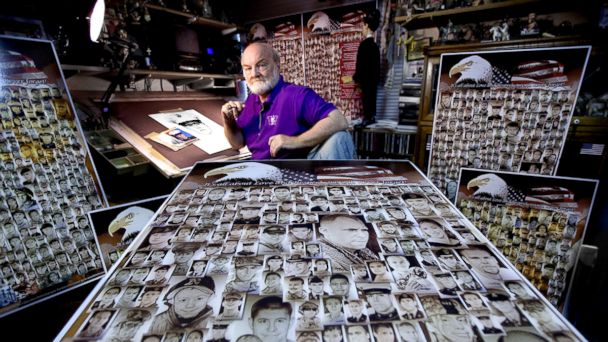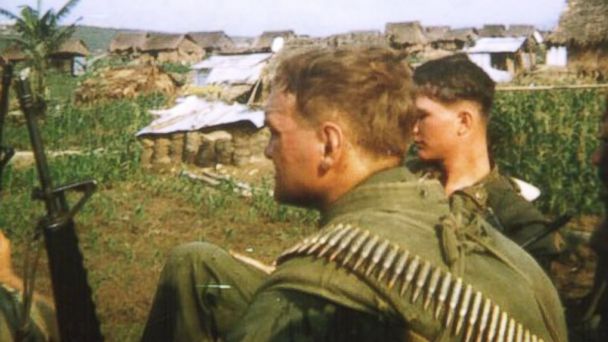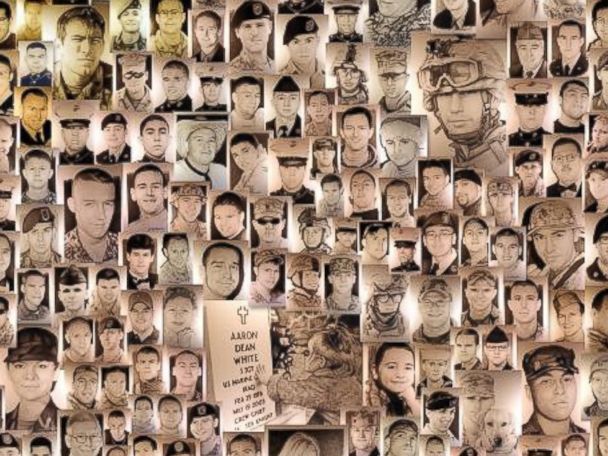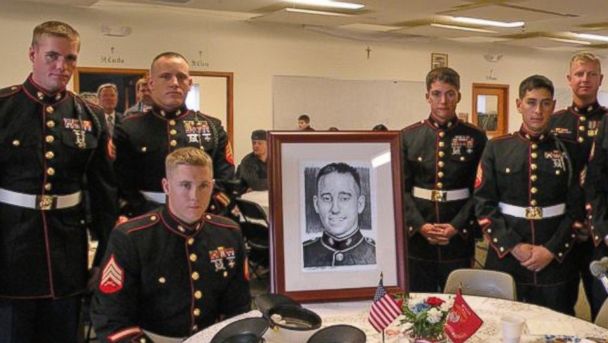3,600 and Counting: Vietnam Vet's Portraits Pay Tribute to Fallen Soldiers
-

- Artist Michael Reagan, Founder of the Fallen Heroes Project in his studio in Everett, Wash. (Scott Eklund, Courtesy Michael Reagan/Fallen Heroes Project)
ABC News' Angel Canales and Arthur Niemynski report:
EVERETT, Wash. - When Michael Reagan came back from the Vietnam War he said there was a piece of him missing. "I joined because there was a war going on, and I felt it was my duty to do that," said Reagan.
Reagan was sent to Con Thien, Vietnam, in the summer of 1967, and he served in the U.S. Marine Corps as a corporal in the 3 rd battalion, 4 th Marine Regiment from 1966 to 1969. "I wondered what am I doing here. There's some pretty scary stuff happening," said Reagan.
His return home wasn't easy, he said. "I remember on April 10 1968, when I landed at the airport. I was spit on and called names. It was not very comfortable." For the next five years, he said, it was very tough for him to adjust to civilian life. "I didn't break any laws but drank a lot, and I was pretty screwed up."

U.S. Marine Corps Cpl Reagan in Con Thien, Vietnam, in the summer of 1967. Michael Reagan/Fallen Heroes Project
Reagan's interest in drawing started while he was in the service. "In Vietnam at the Distribution Management Center, you were either fighting or not doing anything, and rather than sit around and not do anything, I would draw pictures of the Marines I was with or their families, and, sadly, sometimes the only thing that would come home from fallen Marines were the drawings I did," said Reagan.
That desire to become an artist drove him to the Burnley School for Professional Art in Seattle when he was 27 years old. "I didn't realize how hard it was going to be, but the harder it got, the harder I worked, and I knew this was what I wanted to be," said Reagan.
After finishing his three-year program at the Burnley School, he got a job at the University of Washington, and retired after 30 years. During that time, Reagan drew thousands of portraits of major celebrities, movie stars, politicians, heads of state, Playboy Playmates, and he became a very successful artist.
While Reagan drew portraits for profit, he also liked to do charity work, and said he saw it as a way to pay-it-forward after his safe return from the war. "I would get the celebrities to sign some blank illustration boards and redraw their portraits and then would auction those to charities. When I got home I really needed to do something to thank the gods for bringing me back home, because I shouldn't have come home," said Reagan.
After 25 years of portraits, Reagan got a call from a local TV news station in Seattle to do a story, and the station said to him, "You know what Mike? We realized that over the 25 years you've been doing this work for charities, you've raised over $10 million," said Reagan.
That news story was seen nationally, and it was then that a widow whose husband died in combat called Reagan. "I received a call from a Gold Star widow Charisse Johnson from Boise, Idaho, and she said, 'How much would you charge me to do a portrait of my husband? He was a corpsman and died in Iraq in 2003,'" said Reagan. He told Johnson that he would not charge for drawing the portrait of Navy Hospital Corpsman 3rd Class Michael Vann Johnson Jr.
"I'll never forget it. I sent it out, and about two weeks later Charisse called me and said, 'In a year I haven't slept a full night. Yesterday, I received the portrait of my husband, and I'm calling to thank you because when I opened the package and saw the portrait I looked into his eyes. I reconnected instantly with him. I talked to him and was able to finish some of the conversations we didn't get to finish," said Reagan.

Portraits collage of fallen soldiers / Michael Reagan Fallen Heroes Project.
Reagan was very moved by Johnson's wife, and he knew this portrait wasn't going to be his last one after that, and that's how the Fallen Heroes Project was born in 2004. "The year before I did this project I was paid $75,000 by the Mariners to do a painting, but this project took over my life, and I figure I needed to do this. I said to my wife, 'You know this is going to change our life, but it was OK because she knew what this meant to me," said Reagan.
Ten years later and 3,632 portraits to date all done free of charge of fallen soldiers, Reagan continues to pay tribute to the fallen for their ultimate sacrifice. He opens up his email early in the morning and late at night and sees family requests. "I read a lot about the person I draw and look at tapes and videos of the families. I have a spiritual conversation with the person I'm drawing trying to decipher the message they need me to send home. I'll never know the message as long as the picture contains it, so when the families get it whatever happens on the other end happens. I'm the vehicle," said Reagan. He draws an average of two portraits a day every day.

Portrait of 31 year-old Marine Sgt. Jason D. Peto assigned to the 3rd Battalion, 5th Marine Regiment, 1st Division who died from wounds in combat in Afghanistan surrounded by fellow soldiers. Michael Reagan / Fallen Heroes Project
For Reagan, this is a huge adventure, and he feels very fortunate to be a part of it. "There's an incredible amount of trauma and pain for the families who lost these people. They're all proud of their sons and daughters, husbands and wives - all of them. They are allowing me, a total stranger, to play this incredible part. I came home from Vietnam in 1968, I thought whole, but what I actually had when I came home was a hole. This project and these wonderful families that allow me to do this work for them have allowed that hole to be filled in my soul again," said Reagan. "I made a commitment to the Marine Corps, and they taught me what commitment was all about and the Fallen Heroes Project is a lifetime commitment."
Second Tour is an ABC News digital series profiling the lives of military veterans who are doing unique things in the civilian world. For more stories, click here.